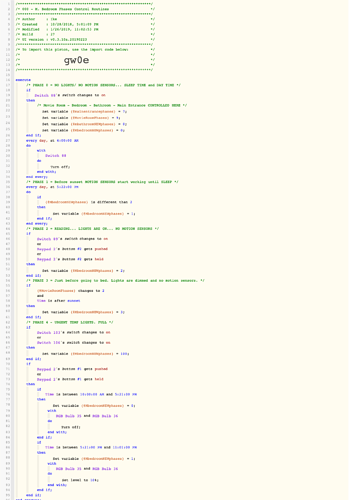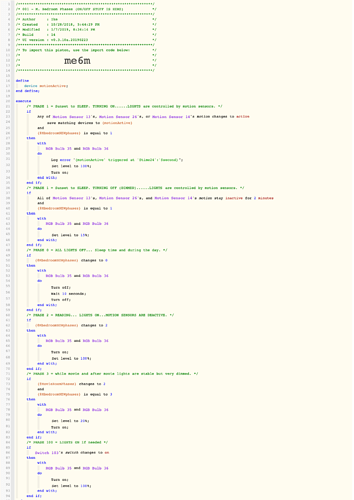Well the first part is the usual stuff:
1- Ipads on the walls with Action tiles (simulated switches determine the global variable number)
2- Alexa voice commands (same simulated switches turn ON / OFF)
3 - Timers
4 - A couple of zwave buttons around the house. (just in case if voice commands fail etc) plus my family sometimes don’t like talking to Alexa LOL
The second part is more like as if the house is “intuitive.”
let me explain how that works:
(I got this design idea from @WCmore while he was working on my house)
Every room is controlled with global variables as I mentioned earlier.
Each room acts according to how other rooms are.
lets say, movie room’s variable is 5. Which means we are watching a movie, sound is blasting, projection is on, lights are off etc.
While movie room changes to 5, halway turns 7. Which means lights are off but if there is motion they turn ON full brightness (bathroom break maybe?)
If movie room is 5 BUT Master bedroom changes to 1, it means one of us is going to bed. Master bedroom 1 turns all the lights off in the bedroom and bathroom and motion sensors are no longer in the picture. only a single sensor controlls a single light bulb in the master bathroom with 25% brightness (mid night bathroom need:)
Since someone went to bed and M. bedroom changed to 1, movie room changes to 6. (meaning lower volume) and halway turns 5, which means lights are still controlled by motion sensors but dimmed to 30% (because people are sleeping now)
Maybe sounds complicated but it’s really not.
in order to make this work properly, you need to take a couple of simple steps.
1 - Your house must be controlled ONLY through WebCore.
2 - You need to design what each room will do on the paper first and decide the variables. Print that out and keep it handy:)
3 - You need two pistons for each room. One determinds the variable, other one controlls stuff
update :
here are two examples i use for the bedroom, incase if anyone else reading this wants to see it.


